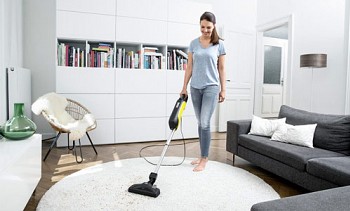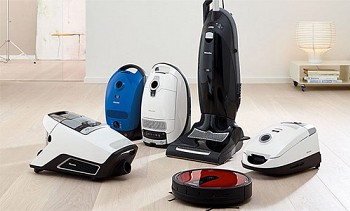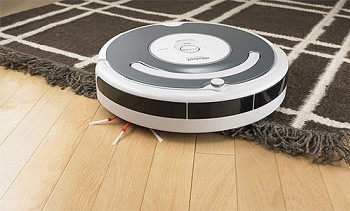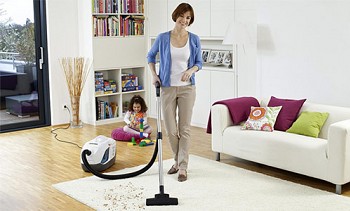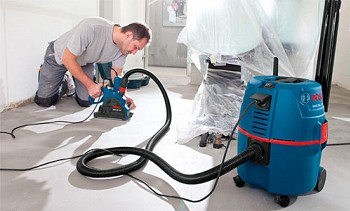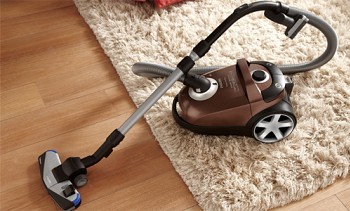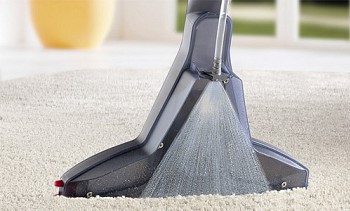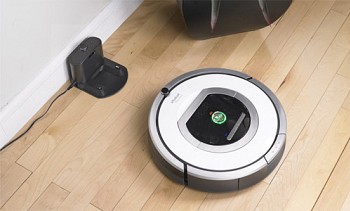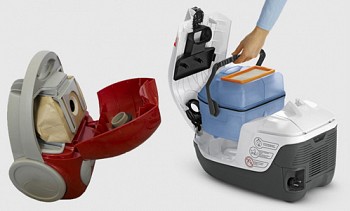Regular cleaning of the living room is the norm for a civilized person. And the vacuum cleaner became the invariable attribute of cleaning in the last century. And if, then, during the appearance of the first vacuum cleaners, it was a question of choosing between a new-fangled electric unit for collecting dust and a simple but familiar broom, today we have to choose between different types of vacuum cleaners.
In order not to spend money on a device that does not suit you, before going to the household appliance store, it will not be superfluous to find out what kind of vacuum cleaners are, how one variety differs from another from the user's point of view, what are their advantages and disadvantages. And we will help you with this.
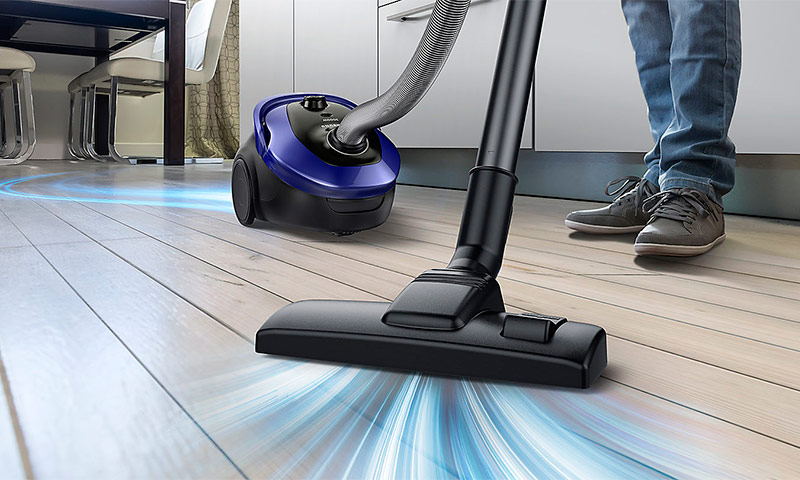
Content:
Types of vacuum cleaners depending on the type of dust collector
Vacuum cleaners with dust bag
Vacuum cleaners with dust bags can safely be called a classic of cleaning equipment. This variety of vacuum cleaners has been around for almost a century, and it has been familiar to all of us since childhood. Some consider the latter circumstance an undoubted advantage, because it is easier to handle familiar equipment. Others, on the contrary, regard this as a flaw: it seems to them that the old is a synonym for being far from perfect. For such skeptics, we note that over the decades that have passed since its inception, the bag vacuum cleaner has changed a lot and learned a lot, while remaining just as easy to use.


+ Pluses of vacuum cleaners with dust bag
- The main advantage of the bag variety of vacuum cleaners is their willingness to work at any time. To bring such an aggregate into operation, just turn on the power. In the same way, upon completion of cleaning, you only need to turn off the vacuum cleaner and send it to a place of permanent storage. And that’s all! It is not necessary to carry out any associated operations each time - to fill the tank with water, clean it, dry it, etc. This means that if you have set aside today, for example, 20 minutes, then you will spend these 20 minutes on cleaning, and not on pre-training and post-maintenance of equipment.
- The garbage collection procedure is simple and hygienic. A bag filled with dust is removed from the vacuum cleaner and sent together with all its contents to a garbage container, and a new one is installed in its place. Of course, in this case we are talking about disposable bags.
- Due to the wide range of prices for bag vacuum cleaners, everyone can choose the equipment that best suits their personal financial capabilities. The same goes for dust bags.

- Cons of vacuum cleaners with dust bag
- Paper bags, dust collectors - a consumable material, which means that it requires periodic financial investments from you, albeit insignificant. Of course, you can take the path of maximum savings and use a reusable fabric dust collector. But to clean the latter is not the most pleasant occupation, and as a rule, they resort to this option only in case of emergency.
- The suction power of the vacuum cleaner decreases as the bag fills. In the case of bags made of synthetic materials, such an effect is almost not noticeable, but for those who use paper, it is well known.
- It happens that dust bags give the owners of vacuum cleaners unpleasant surprises. An object with sharp edges (a glass fragment, a small pebble), falling into a bag, can damage its paper walls. It happens, although it is extremely rare, that a bag, unable to withstand the pressure difference inside and out, simply bursts.As you understand, the consequences of the two cited as an example of incidents are unpleasant. However, the likelihood of such incidents is low, and this happens only with very cheap low-quality bags.
- There are a lot of types of bags for vacuum cleaners, and not everyone will suit your unit. Orientation in the assortment available on sale is sometimes very difficult, especially for those who have recently acquired new equipment. In addition, it should be noted that on the shelves of supermarkets you will find only bags for the most popular models of vacuum cleaners; if yours does not apply to those, you will have to spend a lot of effort looking for suitable supplies.
Aquafilter Vacuum Cleaners
In vacuum cleaners with an aquafilter, the intake air is cleaned in a water tank. When air passes through the water layer, the fine dust particles suspended in it are wetted and settle to the bottom. Such vacuum cleaners are considered "advanced" and for this reason alone are very popular among buyers. However, having started active use of the fashion unit, many users are quickly disappointed, realizing that the water vacuum cleaners, at least in the domestic version, are too far from perfect.


+ Advantages of vacuum cleaners with aquafilter
- Vacuum cleaners allow their owners to save on consumables. You do not have to buy a new dust bag at intervals of 2-3 months. All that is necessary for the operation of such a vacuum cleaner is a small amount of water.
- During the operation of the vacuum cleaner with an aquafilter, the air in the house is inevitably humidified. Thanks to this, it will become easier to breathe in the room, regardless of the quality of cleaning.

- Cons of vacuum cleaners with aquafilter
- Particles with water-repellent properties (feathers or wool coated with a thin layer of fat, plastic shavings, scraps of fabric with impregnation, etc.) are not wetted by water, and therefore do not linger in it. The decrease in the quality of filtration in the aqueous layer leads to the rapid clogging of additional (auxiliary) filters.
- During cleaning, carefully monitor the water level in the tank. Firstly, water under the influence of a strong air stream evaporates rather quickly, and when its level drops below the permissible level, the intake air will not be cleaned. Secondly, when a large amount of garbage accumulates in a water tank (for example, when cleaning a room after repair and construction works), the water level, on the contrary, rises significantly, which leads to increased spraying and / or leakage of the vacuum cleaner. Manufacturers recommend adding water to the tank or completely replacing it after cleaning every 10 square meters of the area (and with severe pollution of the room more often), which, you see, is not very convenient.
- Fluctuations in the water level in the tank, which inevitably occur, for example, when the vacuum cleaner collides with furniture, when moving through obstacles (threshold, carpet, cord of the vacuum cleaner itself), when the hose is jerked sharply, etc., will cause splashing and water leakage from the tank.
- Due to the splashing of dirty water on the additional filters, the latter gradually become contaminated, and sooner or later the question arises of the need to replace them. Those who have already encountered a similar problem know that such filters are very expensive (and finding them on sale is often difficult) - the savings from not having to buy dust bags no longer seem so significant.
- Upon completion of cleaning, it is necessary to thoroughly clean and dry the water container and other structural elements in contact with dirty water. Yes, and to store the vacuum cleaner is strongly recommended unassembled. The fact is that warm humid air is an excellent environment for the propagation of microorganisms, of which there are plenty of it in the vacuum cleaner along with dirt of organic origin.The results of untimely or poor-quality cleaning and drying of the inside of the vacuum cleaner are very unpleasant - an unpleasant odor appears inside the unit and pathogenic microflora are formed. During the subsequent operation of the vacuum cleaner, bacteria and mold and fungal spores will spread and disperse throughout the house with a stream of air. The procedure for cleaning the vacuum cleaner after use often takes no less, if not more, time than cleaning the room itself.
- Vacuum cleaners with an aquafilter capable of providing high quality cleaning of the premises are rather bulky and heavy units. They are inconvenient in operation - they are too heavy, manoeuvrable, prone to tipping over (with all the ensuing consequences).
- Those who wish to become the owner of a good water vacuum cleaner should be prepared to part with a rather impressive amount - the average price for them ranges from $ 500 to $ 1,000. You can, of course, purchase the unit for $ 200-300, but you should not expect high quality cleaning from this.
Cyclone Vacuum Cleaners
The action of cyclone vacuum cleaners is based on centrifugal force. The pinnacle of engineering? In a way, yes. As soon as they appeared on the market, cyclone vacuum cleaners instantly became fashionable and prestigious. To have a similar one at home was considered a sign that you are a modern person who is actively using new technologies. But, as in the case of water vacuum cleaners, the active use of cyclones revealed a huge number of their shortcomings, which ultimately exceeded the number of advantages.


+ Advantages of Cyclone Vacuum Cleaners
- There is no need to regularly purchase dust bags. It is difficult to say exactly how much you will save at the same time - it depends on the area of the room and the frequency of cleaning in it - but hardly more than 500 rubles. in year.
- The suction power does not drop as the container fills. This statement is true, unfortunately, only if the auxiliary filters designed to protect the engine are not clogged. But, as practice shows, these filters remain clean for a very short time.

- Cons of dust extractors with a cyclone filter
- Centrifugal force is only effective against heavy particles. Hair, threads, fluff, household dust settle reluctantly to the bottom of the container, gradually clogging the auxiliary filters of the vacuum cleaner.
- Solid particles falling into the container, rotating, repeatedly collide with its walls. The consequence of this is the increased noise observed by all users of cyclone vacuum cleaners.
- Solid particles spinning under the action of centrifugal force that get inside the vacuum cleaner scratch the plastic walls of the container with their sharp edges. Over time, these walls, which were once transparent, become dull, which makes it difficult to control the condition of the filters and the amount of garbage inside the container.
- Numerous vortex air flows arising during the operation of the cyclone vacuum cleaner charge its plastic parts. That is why cyclones are more likely than their counterparts to accumulate static electricity. The result is a rather painful sensation experienced by the user when touching the unit body.
- The instability of the vortex flows observed when turning on / off the vacuum cleaner, accidentally bending the hose, suctioning the brush to the curtain, clothes or carpet, leads to a decrease in the quality of air purification. In addition, a sharp drop in airflow velocity often becomes the reason that part of the already collected dust is thrown from the container onto the filters, while, of course, their pollution is almost instantaneous.
- After each cleaning (and sometimes in the process), there is a need to clean numerous auxiliary filters. This procedure is unpleasant and time-consuming.
- The rapid deterioration of auxiliary filters, the high cost of new ones and often the inability to find them on a free sale often become the combined reason that owners of cyclone vacuum cleaners are forced to “write off" equipment that has not yet served its term.
Vacuum cleaners with a combined filtration scheme
Many owners of cyclone and water vacuum cleaners, realizing that it is at least inconvenient to operate such equipment every day, continue to use it, but only during general cleaning, and to solve daily small tasks, they purchase an additional vacuum cleaner with a classic bag design - compact and inexpensive.
Some manufacturers have met the wishes of this large category of users and began to produce vacuum cleaners with a combined filtration scheme - with a bag and an aquafilter or with a bag and a cyclone filter. Such aggregates provide the user with the opportunity to choose which filtration method is best to use at the moment - filtering through the water layer (filtering using vortices) or classical filtering using a dust bag.

Varieties of vacuum cleaners by type of construction
Cylindrical Vacuum Cleaners
Cylindrical vacuum cleaners have been and remain the most common in our country. These are the most common hose assemblies familiar to all of us. The cylindrical shape in the case of modern models is already difficult to guess, but this name has historically been assigned to this type of vacuum cleaner.
Cylindrical vacuum cleaners are ideal for everyday tasks. They are lightweight, compact, maneuverable, do an excellent job cleaning in hard-to-reach places (including under furniture) and on flights of stairs. Compared with their closest competitors - vertical vacuum cleaners - cylindrical, as a rule, less noisy and more reliable.
Along with the indisputable advantages, cylindrical vacuum cleaners also have some disadvantages. In particular, the high engine power makes them ineffective in terms of energy saving. Many users will undoubtedly mention the untidiness of their storage as a big drawback of classic vacuum cleaners: a poorly bent hose, as a rule, takes up more space than would be desirable for residents of small-sized apartments, and it does not look very aesthetically pleasing.

Vertical vacuum cleaners
Vertical vacuum cleaners are most widespread in the West - for sure, you saw this in some American movie. Such models are a cylindrical body attached directly to the brush, forming with it as if a single whole.
The main purpose of vertical vacuum cleaners is to clean large areas. And they cope with this task, I must say, not bad. But collecting dust under the bed or in the immediate vicinity of the skirting boards is usually a problem for them. The short cord, which is supplied with almost all models of this type, is very difficult to work with - you have to use an extension cord or constantly change the point of connection to the power supply.
Due to the placement of the motor in the immediate vicinity of the brush, a large power is not required to provide the necessary suction power, which means that a vertical vacuum cleaner can be attributed to an energy-efficient technique. This design also has an unpleasant feature - the loud noise produced by the vacuum cleaner during operation.
Thanks to the presence of a motorized brush, vertical vacuum cleaners do an excellent job of collecting hair - this pet owner will surely like this ability. And when you see how compact and neat this type of vacuum cleaners are in storage, you too will become a fan of it.

Mains powered vertical vacuum cleaner.

Vertical cordless vacuum cleaner.
Vacuum cleaner
A handheld vacuum cleaner can be considered a type of vertical, but much more compact and powered not from the mains, but from batteries.Such devices are designed to clean small surfaces and collect small debris in the most inaccessible places.
The main advantage of a manual vacuum cleaner is its dimensions. Thanks to its compactness and low weight, such devices allow you to get to the most distant and seemingly inaccessible corners, and even children can cope with them. Yes, and you will not have questions with the storage of equipment - there is always a place for such a baby.
Of course, not without drawbacks. The main one, characteristic of any battery-powered technology, is its limited run time and long recharge time. However, since there is no question of a full-fledged cleaning of a large area with a handheld vacuum cleaner, it is quite possible to put up with this.

Built-in vacuum cleaners
The built-in (or stationary) vacuum cleaner is a powerful dust removal system, the power unit of which is installed in the utility room. Connection to this central unit is via pneumatic outlets mounted in the walls of living rooms. All you have to do to start cleaning is to plug the hose into one of these air inlets. In this case, electrical contacts are closed, which actuate the entire system. Air sucked in by the hose, along with dust and other small debris, enters the dust collector of the built-in vacuum cleaner through the air ducts
Without difficulty, there are three indisputable advantages of built-in vacuum cleaners. Firstly, it’s convenient to work with such equipment - you don’t need to carry (or carry) a vacuum cleaner from room to room, just reconnect the hose to another air outlet. Secondly, the built-in vacuum cleaners work silently (the vacuum cleaner motor, of course, creates noise, and it’s quite a lot, but since it is located somewhere far away, the user does not hear it). Thirdly, the air flow coming from the vacuum cleaner cannot pick up dust from surfaces that have not yet been cleaned, because the exhaust is in the same place as the power unit, i.e. in the technical room.
The disadvantages of this kind of vacuum cleaners are also obvious. Firstly, the suction power of such vacuum cleaners is relatively small, which is a consequence of the large length of the ducts connecting the access points to the power unit. Secondly, cleaning the clogged built-in duct (and the probability of this is by no means small) is not an easy task, as a rule, it requires the involvement of a specialist. Thirdly, the residual dust in the ducts is a breeding ground for dust mites. Well, and, of course, many simply cannot afford such a technique - it scares off the price of the vacuum cleaner itself, and the cost of its installation and maintenance.


A separate variant is the built-in base vacuum cleaners, which are mounted in the base of the kitchen and allow you to quickly collect garbage in the kitchen.
Vacuum cleaner robot
The dream of many to integrate robotics into everyday life begins to come true. The first robot to come to the service of people to help solve small household problems was a robot vacuum cleaner.
The robot vacuum cleaner, orienting in space with the help of ultrasound, easily “recognizes” the walls, legs of furniture, doorways, stairs. Moreover, in his electronic "brains" a certain "map of the area" is formed, which means that the next time it will take less time to scan the space. When the robot’s batteries sit down, it easily finds its charger, and after recharging it resumes cleaning from the very place where it was suspended. Being very compact, it easily climbs under the bed and other furniture, which cannot be reached with an ordinary vacuum cleaner. What the robot vacuum cleaner cannot do is to unload the collected dust. But after all, the owner must leave at least a little work ...
Many consider robots to be just a toy. This is partly true. In terms of suction power, these small devices cannot compete with their large and powerful brothers. But then they take perseverance.Unlike a person, a robot will persistently execute the program laid down in it, without referring to employment, fatigue, a headache ... Of course, you should not expect that for a penny you can get a full-fledged assistant: when buying a cheap robot vacuum cleaner, you get a toy ...

Types of vacuum cleaners depending on the method of cleaning
Vacuum cleaners for dry cleaning
The vast majority of vacuum cleaners sold are vacuum cleaners designed for dry cleaning. The principle of operation of such units is already known to you: a rapidly rotating fan creates a vacuum and, due to this, draws in air with dust and small debris trapped under the brush, in the future this air passes through the filtering system and is already cleaned and is released back into the atmosphere.

Vacuum Cleaners
Washing vacuum cleaners can do the same as their counterparts, but in addition they are also suitable for wet cleaning. To clean the floor, collect spilled liquid or moist garbage for them is not difficult.
How does this technique work? Inside the washing vacuum cleaner there are two tanks with water. From the first, water (pure or with a detergent dissolved in it) flows through special capillaries and is sprayed, moistening evenly the surface of the floor under the brush. Under the action of the discharge, dirty water, which has become such in the process of mixing with dust, is sucked into the dirt channels and enters a second tank, designed to collect "mining".
Vacuum cleaners are an indispensable thing for large families and owners of several pets. He will become an indispensable assistant during the general cleaning in a large apartment or house. But for a small daily cleaning of a small-sized apartment, a washing vacuum cleaner, with all its advantages, is not very suitable - for such tasks it is too large, heavy, slow and requires a lot of time for maintenance upon completion of work.

Types of vacuum cleaners, depending on the purpose
The vast majority of vacuum cleaners are designed for cleaning residential premises. But there is a cleaning technique that has another highly specialized purpose. First of all, we are talking about construction and car vacuum cleaners.
Construction Vacuum Cleaners
At first glance, a construction vacuum cleaner is no different from the size of an ordinary household vacuum cleaner. However, having the same principle of operation and a similar device, it is still designed to solve completely different problems.
A household vacuum cleaner that copes well with ordinary household dust, small pebbles will most likely not be able to. The situation will be worse if fine-grained building dust is on his way: he, of course, will easily “absorb” it, but also easily “spit it out” of himself along with the air stream. The most sad thing is that part of the "undigested" dust will fall into the engine, which is likely to cause equipment failure.
The construction vacuum cleaner was originally designed to collect large volumes of industrial and construction waste - chips, small stones, wood or cement dust, etc. This is possible due to the fact that such a vacuum cleaner has a particularly powerful engine, a highly efficient multi-stage filtration system, an increased dust collector volume, and a larger than usual hose diameter.

Car vacuum cleaners
A car vacuum cleaner, as its name implies, is designed to clean the inside of a car. Thanks to its compact size, it allows you to reach the most inaccessible places. Some car vacuum cleaners are capable of sucking up liquid, which is especially useful in winter, when whole puddles from melted snow accumulate on car mats.
A car vacuum cleaner can operate either from the car's on-board network or from a battery. To work the first variety requires only a connection to the cigarette lighter. Cordless car vacuum cleaners require constant recharging, but if necessary, can be used outside the car.


